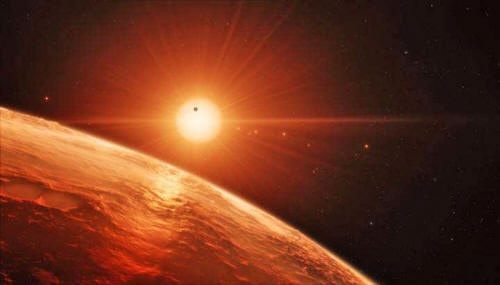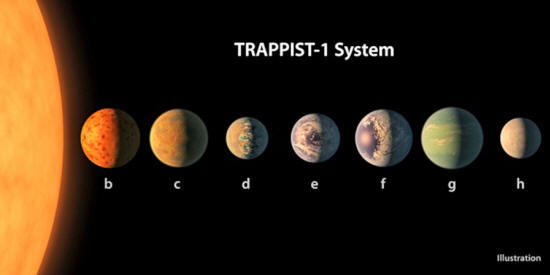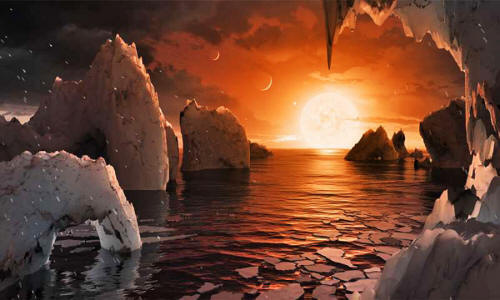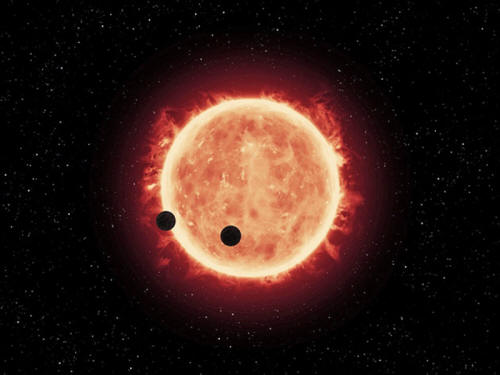|
from
PHYS Website shows the view from the surface of one of the planets in the TRAPPIST-1 system. At least seven planets orbit this ultra cool dwarf star 40 light-years from Earth and they are all roughly the same size as the Earth. They are at the right distances from their star for liquid water to exist on the surfaces of several of them. Credit: ESO/M. Kornmesser
They were detected as they passed in front of their parent star, the dwarf star TRAPPIST-1. Three of them lie in the habitable zone and could harbor water, increasing the possibility that the system could play host to life.
It has both the largest
number of Earth-sized planets yet found and the largest number of
worlds that could support
liquid water.
...as well as other telescopes around the world, have now confirmed the existence of at least seven small planets orbiting the cool red dwarf star TRAPPIST-1.
All the planets, labeled
TRAPPIST-1b, c, d, e, f, g and h in order of increasing distance
from their parent star, have sizes similar to Earth.
They found that at least
the inner six planets are comparable in both size and temperature to
the Earth.
This artist's concept shows what the TRAPPIST-1 planetary system may look like, based on available data about the planets' diameters, masses and distances from the host star.
Credit: NASA-JPL/Caltech
Astronomers expected that
such dwarf stars might host many Earth-sized planets in tight
orbits, making them promising targets in the hunt for
extraterrestrial life, but TRAPPIST-1 is the first such system to be
found.
The team determined that all the planets in the system are similar in size to Earth and Venus in the Solar System, or slightly smaller.
The density measurements suggest that at least the innermost six are probably rocky in composition.
Imagine standing on the surface of the exoplanet TRAPPIST-1f. This artist's concept is one interpretation of what it could look like.
Credit: NASA/JPL-Caltech
However, TRAPPIST-1's small size and low temperature mean that the energy input to its planets is similar to that received by the inner planets in our Solar System.
TRAPPIST-1c, d and f receive similar amounts of energy
to Venus, Earth and Mars, respectively.
Climate models suggest the innermost planets, TRAPPIST-1b, c and d, are probably too hot to support liquid water, except maybe on a small fraction of their surfaces.
The orbital distance of the system's outermost planet, TRAPPIST-1h, is unconfirmed, though it is likely to be too distant and cold to harbor liquid water - assuming no alternative heating processes are occurring.
TRAPPIST-1e, f, and g, however, represent the holy grail for
planet-hunting astronomers, as they orbit in the star's habitable
zone.
The NASA/ESA Hubble Space Telescope is already being used to search for atmospheres around the planets and team member EmmanuŽl Jehin is excited about the future possibilities:
This research was
presented in a paper entitled "Seven
Temperate Terrestrial Planets Around the Nearby Ultracool Dwarf Star
TRAPPIST-1", by M. Gillon
et al., to appear in the journal Nature. doi:10.1038/nature21360
...could help Explain how Planets Form from Nature Website
shows two Earth-sized planets spinning across the face of
an M
dwarf star called TRAPPIST-1.
The Earth-sized astronomical bounty circles a dim star that flew under the radar of exoplanet researchers.
The planetary menagerie
exists around a star overlooked by other
exoplanet hunters, although
it is just 12 parsecs (39 light years) from Earth.
All of them orbit at the right distance to possibly have liquid water somewhere on their surfaces.
Some of the planets were announced last year, but the authors debuted five newfound ones in a paper published on 22 February in Nature.1
Because the system is so close to Earth, astronomers can study the planets' atmospheres relatively easily.
That could reveal an astonishing diversity of worlds, ranging in composition from rocky to icy.
It's also vindication for astronomers who hunt for planets around the cool, dim stars known as M dwarfs.
These are the most common type of star in the Milky Way, but many exoplanet searches have focused instead on bigger and brighter stars that more closely resemble the Sun.
Even NASA's Kepler space telescope, which found most of the more than 4,700 planetary candidates known so far, turned to M dwarfs only recently.
Magnificent seven
MichaŽl Gillon leads the TRAPPIST collaboration, which hunts for planets using two 60-centimetre telescopes:
They look for the faint dimming of a star's light that occurs when a planet moves across its face.
The team initially reported three planets around the star, known as TRAPPIST-1, last May.2
The team had caught only two glimpses of one of those planets, so they followed up on the faint signals with other telescopes. That process included 20 consecutive days when NASA's Spitzer Space Telescope stared at the star.
The resulting data revealed that what the scientists thought was a single planet was actually four that orbit their star roughly every 4, 6, 9 and 12 days.
Those four joined the two innermost planets, which whirl around the star once every 1.5 days and 2.4 days. The team also caught a hint of a seventh, more distant planet.
Gillon says that the six inner planets probably formed farther away from their star and then migrated inward. Now, they are so close to each other that their gravitational fields interact, nudging one another in ways that enabled the team to estimate each planet's mass.
They range from around 0.4 to 1.4 times the mass of the Earth.
NASA/JPL-Caltech An artist's illustration of what TRAPPIST-1's seven planets might look like.
Closing in
Venus and Earth started out in similar conditions, but ended up in two highly different states; 'uninhabitable' Venus is now choked under a dense blanket of clouds.
The TRAPPIST-1 system probably has a similar variety of worlds.
Although at least some fraction of each planet could harbor liquid water, it doesn't necessarily follow that they are habitable.
TRAPPIST-1 emits about the same amount of X-ray and ultraviolet radiation as the Sun does, which could chew away at any protective atmospheres the planets might have.3
And the worlds are likely locked into orbits where the
same hemisphere always faces the star, rendering them permanently
half-lit and half-dark. That would make it much more challenging for
life to thrive.
Kepler is also observing the system and will gather data that can better pin down the planetary masses, says Courtney Dressing, an astronomer at the California Institute of Technology in Pasadena.
And the TRAPPIST team is building four new 1-metre-diameter telescopes in Chile to continue the work.
|





